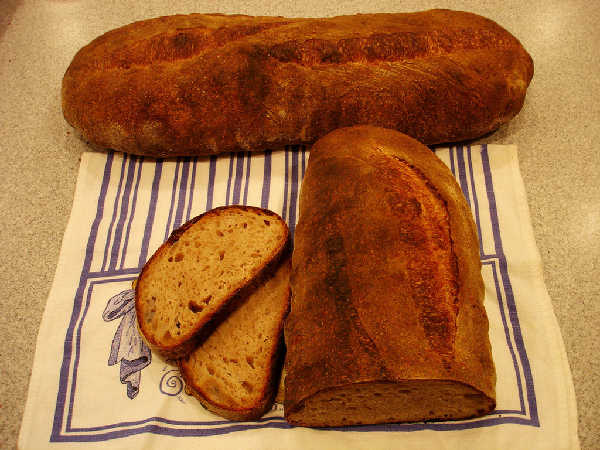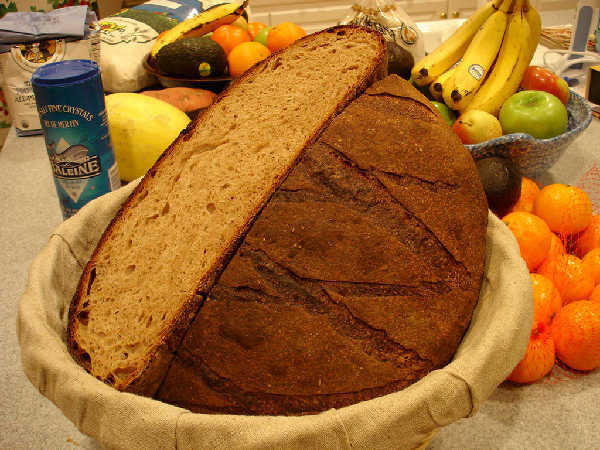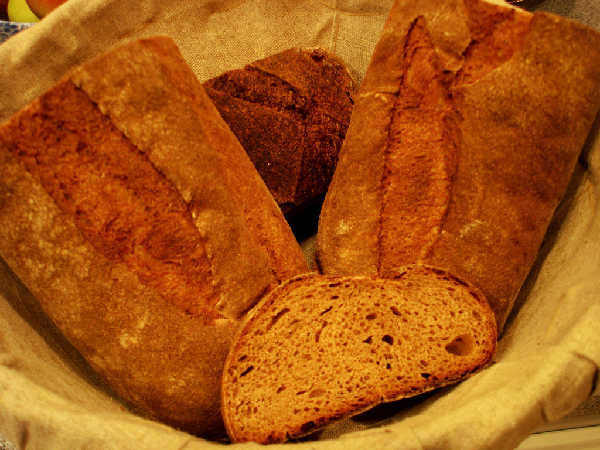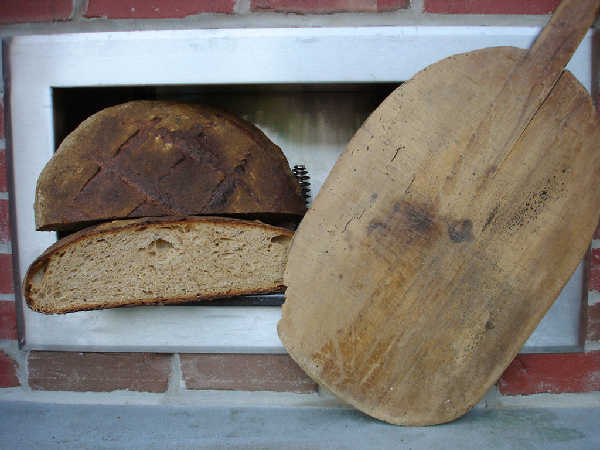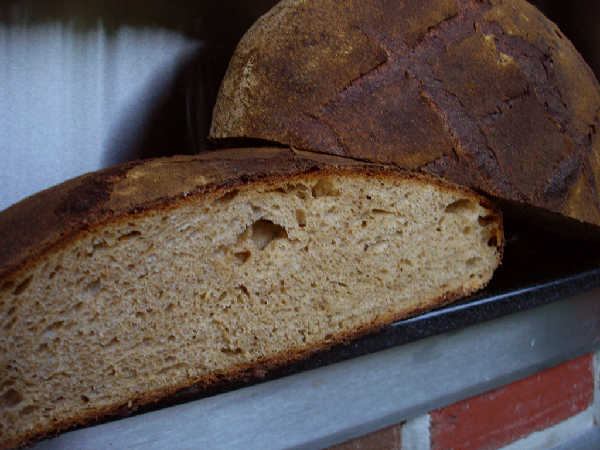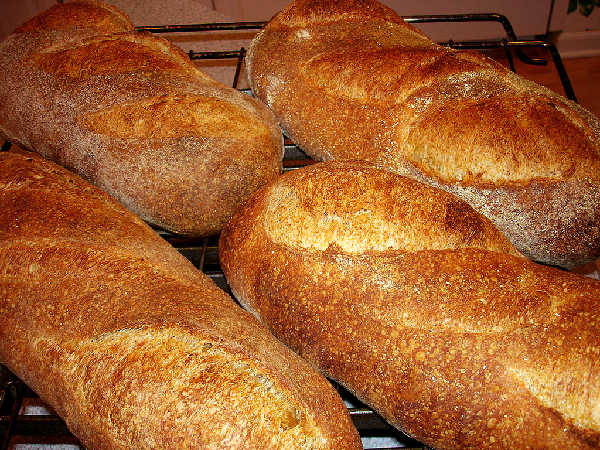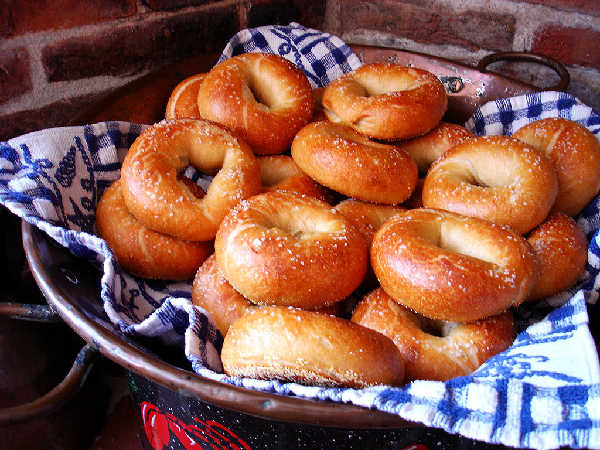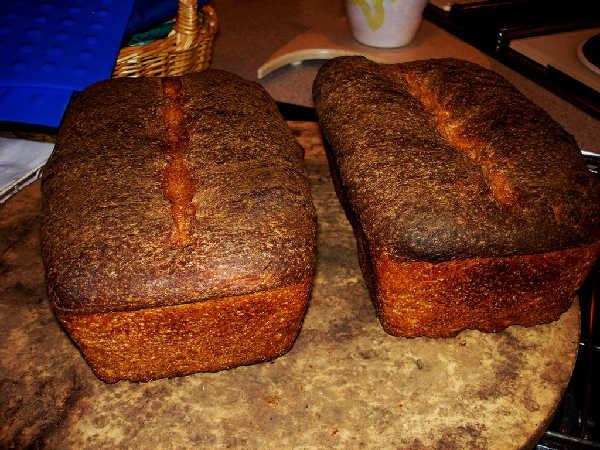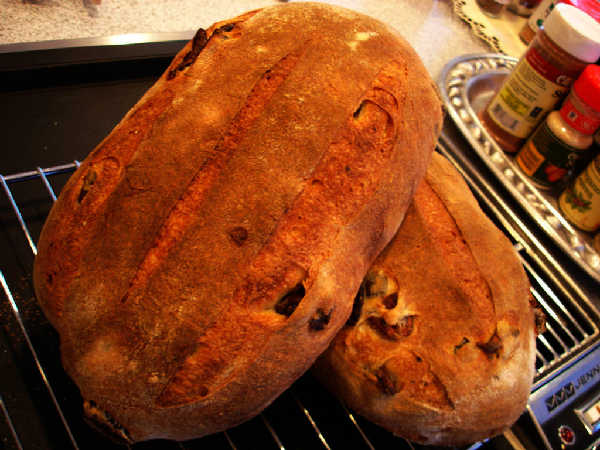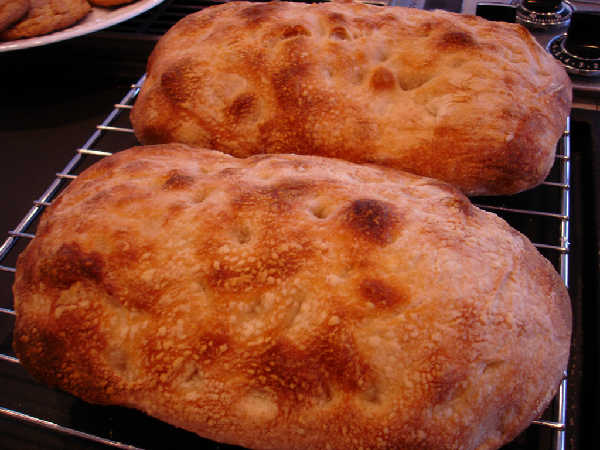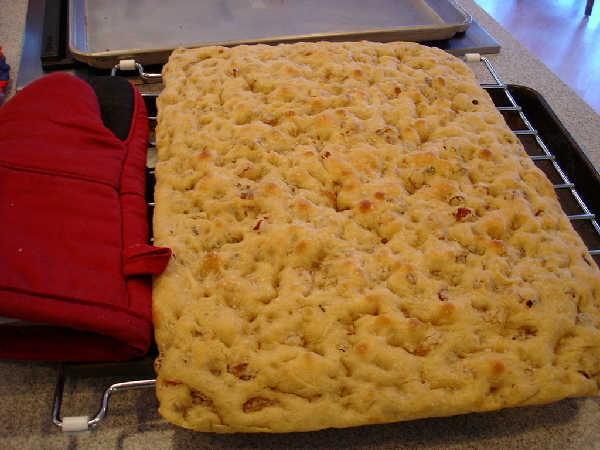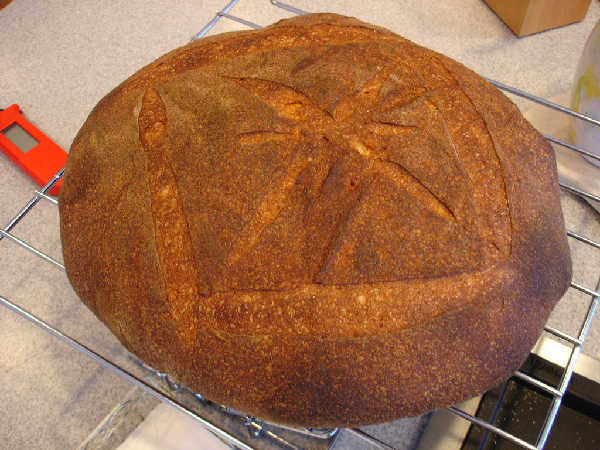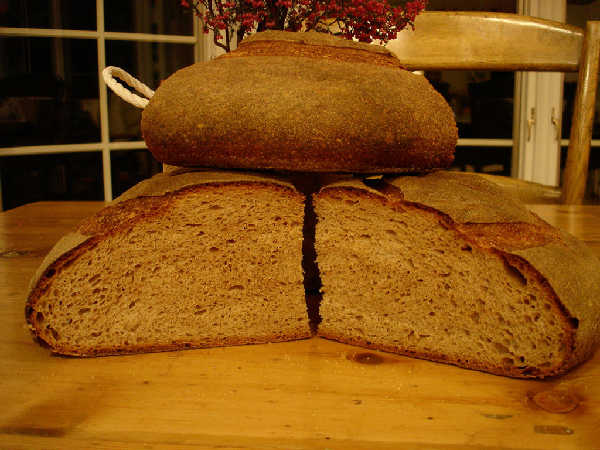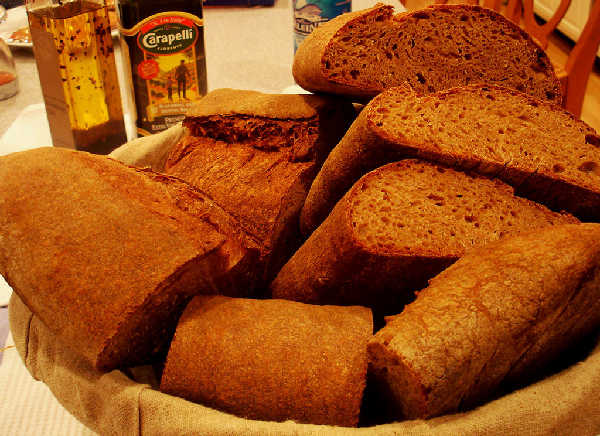
Saturday, December 15, 2007
Thursday, December 6, 2007
Sunday, December 2, 2007
Two Sourdough Focaccias - Raisin and Savory
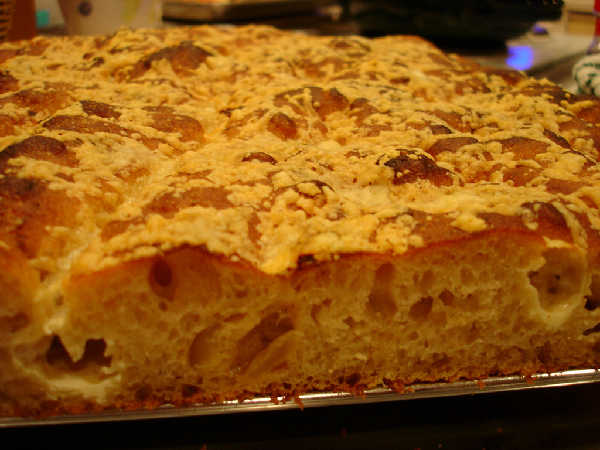
.
I spent the day making a couple of sourdough focaccias and a miche that is similar to the Thom Leonard Country French recipe in Artisan Baking by Maggie Glezer. The recipe for the focaccias follows.
A spread sheet in xls format and html format for the dough is posted, which has amounts in ounces and bakers percentages, percent of fermented flour and other possibly useful information. Some photos of the process are posted, as well.
Thursday, October 18, 2007
Paella de Camarones y Langosta
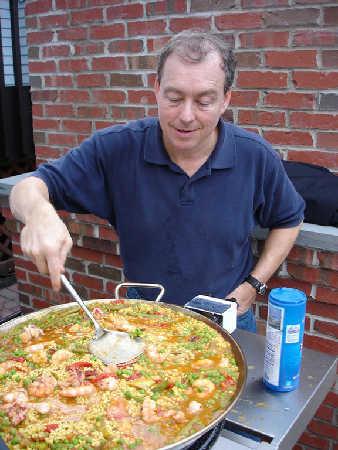
This paella is based on "Paella con Mariscos" recipes. I know my kids love large shrimp and lobster, so I decided to focus on these ingredients for a seafood based paella. It wasn't clear what vegetables, if any ought to be included, but we have some very good artichokes and some organic green beans that seemed fresh in the store, so I decided to work with them, since they are common in other paella recipes. Probably, I have missed the ideal combination of ingredients for a paella with seafood, but my family loved this dish.
Labels:
Cooking
Location:
New Vernon, NJ 07960, USA
Friday, October 12, 2007
Pane Casareccio e Lariano di Genzano
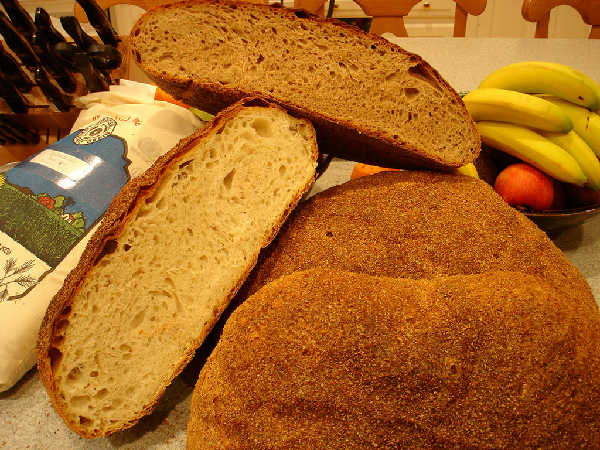
Daniel Leader's Local Breads has a fascinating story of his visit to Genzano, where he saw them make large, almost charred looking, bran dusted breads raised with a biga naturale, an Italian firm sourdough levain. I enjoyed hearing about his visit with Sergio, while they mixed, raised, and loaded 64 very large loaves into a wood-fired oven. Now that I have a brick oven in my back yard, I thought I'd give a try at making these loaves in the size he says he observed at the bakery he visited. He says they created approximately 8 pound loaves that were loaded eight at a time into an eight foot long by one foot wide by about 4 inches tall box with divisions in it for eight loaves. Thanks to Zolablue for doing this recipe as shown in Leader's book and writing about it in her blog, which provided inspiration as well as lots of information and photos.
Thursday, October 11, 2007
Friday, October 5, 2007
NYT No-Knead Sourdough Conversion
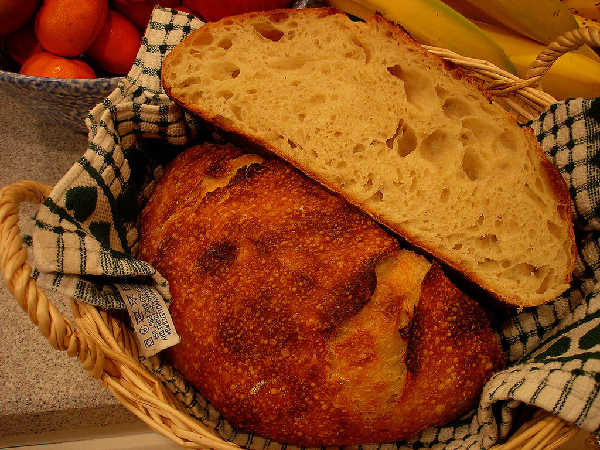
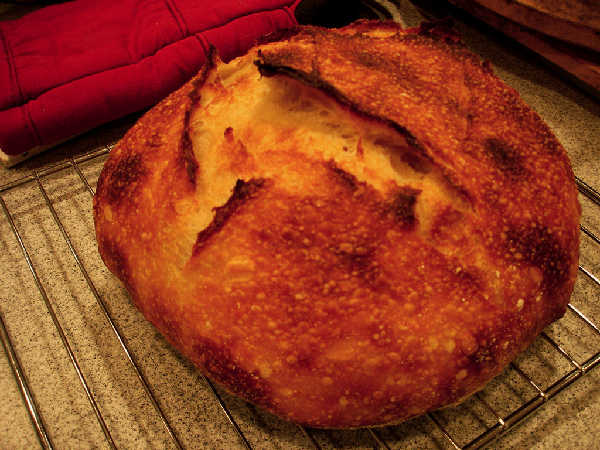
I haven't tried the NYT No-Knead recipe, although I've read some of the discussions on The Fresh Loaf along the way. Based on some questions from KipperCat about the amount of starter that should go in a sourdough conversion of the recipe, I decided to give converting this recipe to sourdough a try.
I've tried to stay very close to the recipe in The New York Times, although I did a few things differently - some good, some bad, probably.
I have some photos of the process and also a spreadsheet in html or xls format.
Ingredients
- 15 grams (1/2 oz, 1 tbsp) of 90% to 100% hydration white flour starter or 12 grams of firm Glezer style starter or similar.
- 346g (12 oz, 1.5 cups) water
- 450g (16 oz, 3.25 cups) bread flour, should be stronger flour if possible.
- 9g Salt
Mix water and starter and stir vigorously until starter is fully dissolved. Mix flour and salt to fully distribute salt. Put flour and salt together and use a dough scraper to work the flour into the water. Continue working around the bowl scraping dough from the side toward the center and pushing it down in the center, until you have a shaggy mass. Do a few "french folds" (I still don't know what to call this technique) as in the video I took, if you want, but this step can be omitted. Place dough in covered bowl to rise at 75F for 10 hours.
At 70F it needs to rise for about 13.5 hours. Or, at 70F, use 45g of starter instead of 15g to have a rise time of about 10 hours. Similarly, at 65F try using about 130g of starter. If using larger amounts of 90% starter, remember to adjust the water down in the final dough. For example, for 45g of 90% hydration starter, reduce water by about 15g or 1/2 oz, and for 130g of 90% hydration, reduce water by 50g or almost 2oz.
As you can see, an important aspect of the sourdough conversion is knowing the temperature and how fast your starter is. The above suggestions for the various temperatures would work for my 90% hydration starter, which would double from a feeding of 10g:50g:50g (starter:water:flour by weight) in 6 hours at 75F. The firm version of my starter at 60% hydration would double in volume in 5.5 hours if you fed it (10g:50g:50g) at 75F. At 70F the respective rise times for 90% hydration and 60% hydration starters would be 8.25 hours and 7.5 hours, respectively.
The dough should roughly double in volume or a little less. It's not too important if it doesn't make it all the way to double, and it's probably better to lean toward stopping the fermentation and moving on to shaping earlier, rather than overfementing the dough.
Shaping
I have a video of my attempt at this. I was not used to the gloppy dough you get after letting it rise without folding for so long, but I pressed forward. Scrape the dough out onto a lightly dusted surface. Fold it over itself letter style, turn 90 degrees and repeat. I then attempted to form a boule, but I found it sticking to me and to the surface, so I turned it upside down and made the boule by gathering the sides in toward the middle and pressing together, as you can see in the video.
Place the round loaf seam down on parchment paper dusted with some regular flour and some semolina or corn meal. Place the whole thing in a "ziploc" big bag, or find some other airtight container for the final rise. Place a bowl of water in with the loaf to create a humid environment to avoid a dry skin on the loaf.
The final rise should take about 2 hours at 75F, 2.5 hours at 70F, and 3.5 hours at 65F.
Slash and Bake
Here again, I have provided a video of my somewhat frightening slashing attempts, as well as of lowering the loaf into the dutch oven.
Preheat the dutch oven to 425F about 1/2 hour before baking.
Slashing is optional. AnnieT suggested that this loaf needs no slashing and cracks on top during baking, resulting in a rustic look. I did slash it, but it's somewhat difficult to do with a wet dough like this. Getting the lame wet helps. A very shallow cut at an angle is less likely to stick.
Be very careful to use thick, heat resistant hotpads or very heavy oven mitts. A cast iron dutch oven preheated to 425F is dangerous to move. Be warned. Be sure to have a place prepared for the dutch oven and the lid that is heat resistant when you remove them from the oven.
Drop the loaf, holding it by the parchment into the dutch oven. Place the lid on top. Place the whole dutch oven back in the oven. I baked it for 25 minutes, less than the recipe states, as I was worried about discovering a small piece of charcoal in the dutch oven if I let it bake too long. It was fine, though, and not even that brown after 25 minutes at 425F. At this point, I should have just left the lid ajar and placed the whole thing back in the oven. However, I removed the loaf from the dutch oven, removed the parchment paper, which was very easy, and placed the loaf on the oven rack. It took only a few minutes for the ears on the loaf to start burning. The internal temperature was about 207F, but as is typical with higher hydration doughs, it was somewhat underbaked. Faced with a choice between burnt ears and an underbaked loaf, I decided to just stop the bake. I like to toast or reheat my bread in the next days anyway, so underbaking it is fine for that situation. However, I would in the future keep it in the dutch oven and hope that with the lid only partially ajar, it would keep it from scorching and allow a longer bake.
Summarizing, bake for 30 minutes at 425F with the lid closed, then place lid so it is slightly ajar to let steam escape, and allow it to bake to a dark golden brown color 10-20 minutes more, probably.
Results
The flavor was excellent. The crust was a little thin and soft, due to my poor decisions during the baking described above. However, it still tastes great and is easily rectified by reheating or toasting. The crumb is what I find typical of higher hydration loaves. The texture is spongey and light with a moist, cool, creamy feel. This bread reminds me very much of the "Pagnotta" recipe in my blog.
Wednesday, October 3, 2007
Arroz Con Pollo Peruano - Paella Style
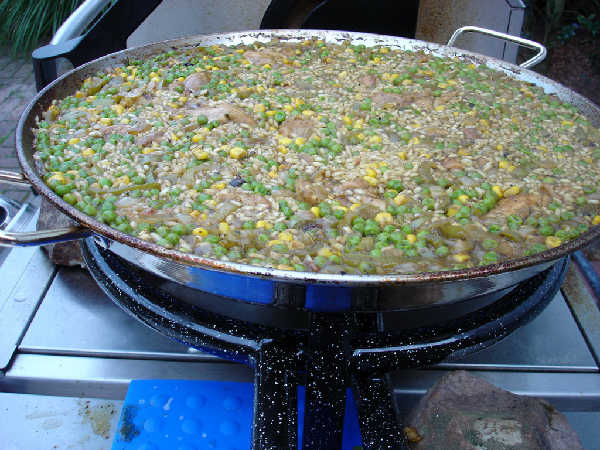
This is not exactly Peruvian style "Arroz Con Pollo". However, it is inspired by recipes for this dish from Peru and is not too different in flavor from the typical recipe. One main difference is I'm using arborio rice instead of a long grain rice that might be more typical for this dish, and I'm making it in a paella pan instead of doing it in a larger covered stock pot or similar vessel. Also, there are some ingredients not available here in suburban NJ, like the typical aji amarillo from Peru. I'm doing what I can to make something similar, given the ingredients available at the local grocery stores.
Labels:
Cooking
Location:
New Vernon, NJ 07960, USA
Tuesday, October 2, 2007
Brick Oven Roasted Suckling Pig
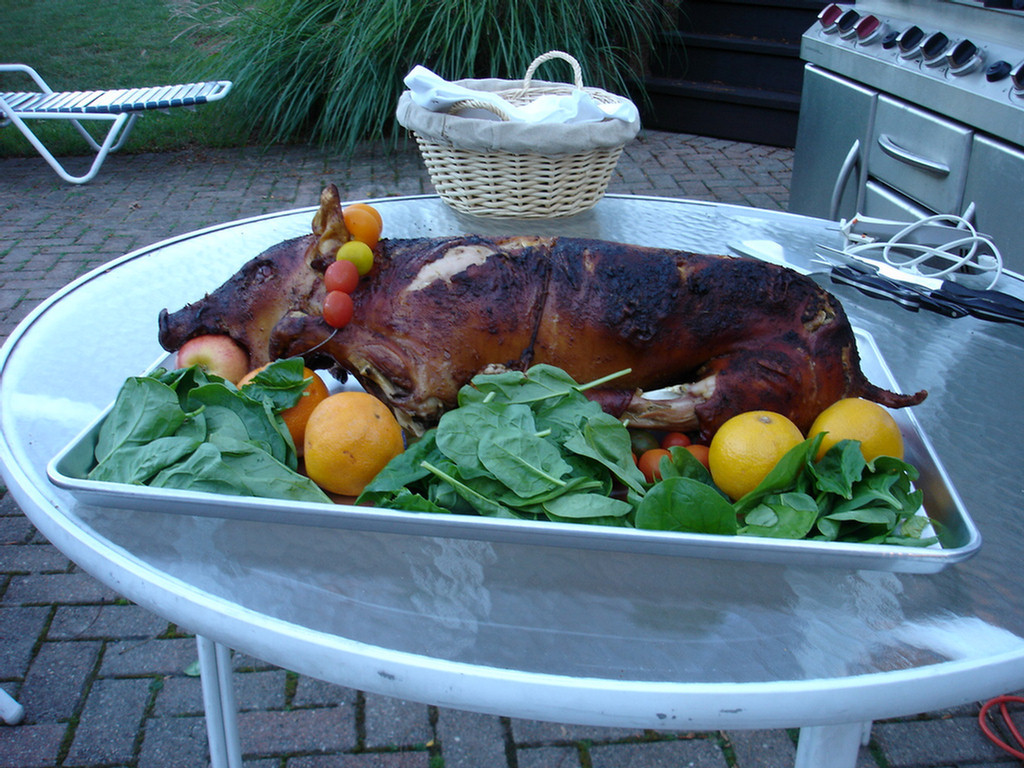
I've been trying to figure out interesting things to do with my new Woodstone oven. A whole suckling pig, once thought of, was compelling. Roasting a whole suckling pig in the oven was an adventure for an engineer. It's not a dish for the faint of heart.
I took some photos of the process.
Labels:
Cooking
Location:
New Vernon, NJ 07960, USA
Thursday, September 27, 2007
Paella With Chicken, Chorizo, Vegetables
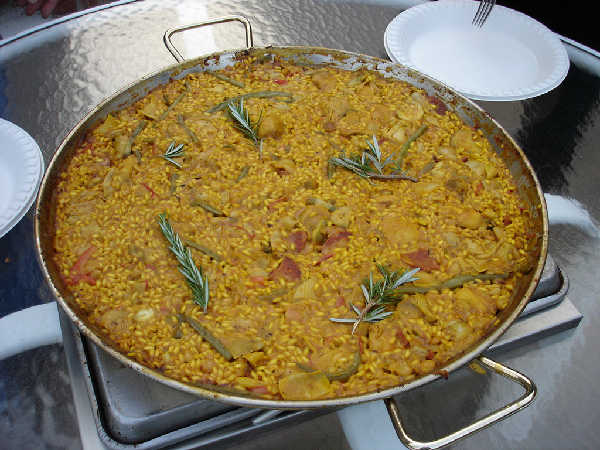
This is essentially Paella Valenciana, but I know true Valencians will say it's not correct in various ways, so I don't want to call it a Paella Valenciana. It has some mild chorizo added, which I'm fairly sure is not traditional. Of course, I am using various ingredients available to me here in suburban New Jersey grocery stores, so the vegetables aren't quite the same as what I would obtain in Valencia. So, my apologies for even mentioning that it is close to Paella Valenciana, although it certainly is derived from recipes I found on the internet for Paella Valenciana and doesn't deviate too far from them.
Labels:
Cooking
Location:
New Vernon, NJ 07960, USA
Wednesday, September 12, 2007
Sunday, September 9, 2007
Sourdough Rise Time Modelling and Recipe Calculators
I've posted a spreadsheet that summarizes what I do these days to analyze rise times and to dissect recipes or design my own variations. Below is some discussion and also some instructions for the spreadsheet. Use it as is, and modify it as you like. It may contain errors, bugs, and it is not carefully designed to work on all computers and operating systems. It uses "macros", which you have to enable, and it probably will only work with relatively recent versions of Excel that would be available in Microsoft Office 2003 or later. I notice that I can use the spreadsheet on a Macbook with Microsoft Office 2004 for Mac installed on it.
I've built some models of fermentation rates and rise times over the last few years. There is no science here, just trial and error in an attempt to engineer an admittedly crude but hopefully useful model based partly on observations and partly on what little I can gather from some scientific papers and a few baking books. You can beat me up if you want with general treatises on all the ways this doesn't make sense or can't possibly work or is theoretically completely incorrect. I already am well aware I'm skating on thin ice (or possibly am in a coma under the ice already) in any sort of rigorous intellectual or scientific sense. However, if you want to make some specific constructive suggestions or point out neat ways to get a good handle on this or that factor or places where you think the model gives wrong answers and what should be the right answer, that would be interesting.
I've built some models of fermentation rates and rise times over the last few years. There is no science here, just trial and error in an attempt to engineer an admittedly crude but hopefully useful model based partly on observations and partly on what little I can gather from some scientific papers and a few baking books. You can beat me up if you want with general treatises on all the ways this doesn't make sense or can't possibly work or is theoretically completely incorrect. I already am well aware I'm skating on thin ice (or possibly am in a coma under the ice already) in any sort of rigorous intellectual or scientific sense. However, if you want to make some specific constructive suggestions or point out neat ways to get a good handle on this or that factor or places where you think the model gives wrong answers and what should be the right answer, that would be interesting.
Saturday, September 8, 2007
Saturday, July 7, 2007
Tuesday, July 3, 2007
Whole Grain Sourdough Sandwich Bread
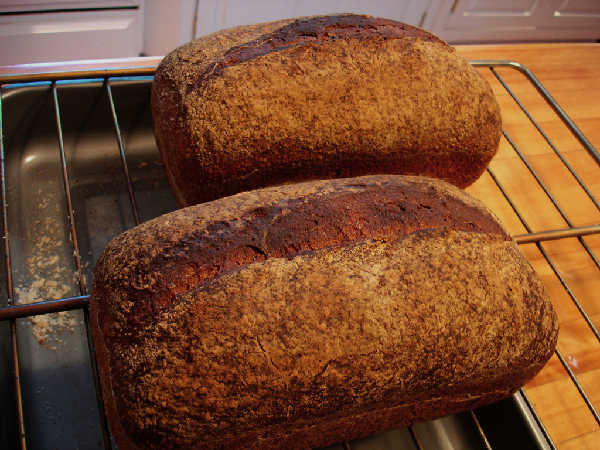
This bread is an attempt to improve on the results from a previous blog entry. This one also has a spelt levain, but it was designed to rise overnight with only a small quantity of 90% hydration white flour starter added. The levain was added to the dough when it was not very ripe, before it had peaked and dipped. The percentage of fermented flour is about 32%, but the less ripe starter results in flavor and dough handling more like what you would expect if you used a lower percentage of fermented flour. The whole spelt flour contributes a characteristic nutty, slightly sweet flavor to the bread. I was very happy with the flavor resulting from this combination of flours and plan to use it more often for this bread and for my favorite mixed grain miche recipe. The hydration is about 83%, which for a whole grain bread is not enough to make it very wet or difficult to handle. However, it is a slightly slack and sticky dough. It should spread out only a little bit after sitting on the counter, not like a very wet ciabatta dough that might spread out more quickly and more or less pour out of the bowl until it has been folded more.
Wednesday, June 13, 2007
Sourdough Bagels
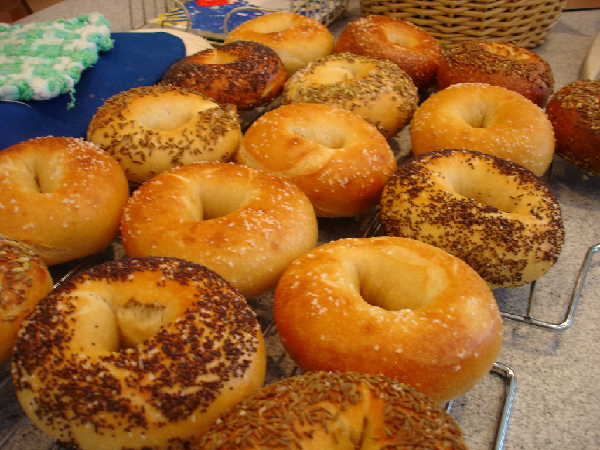
Many thanks to Susanfnp for posting a great sourdough bagel recipe based on Nancy Silverton's bagel recipe. She also provided a number of key tips as I made these. I posted some photos process, as well as a spreadsheet with more details such as bakers percentages and preferment percentages.
Monday, June 4, 2007
Seawater Sourdough Wheat Bread
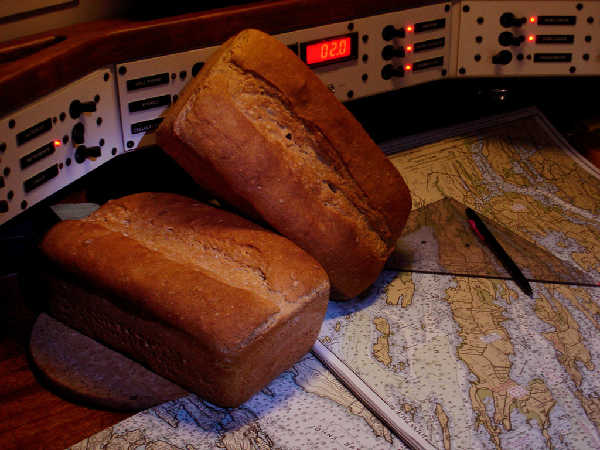
Xma commented about trying seawater in bread on a diving trip. I decided to give this a try.
Please note: I have not researched health hazards that may result from using raw seawater directly in bread dough.
Based on some discussion on the internet, it seems that seawater has a salinity of approximately 32 to 35 parts per thousand. However, not all of the ions are Na+ or Cl-. In fact, seawater is a complex combination of various salts. However, as a naive assumption, I used 3.2% grams of salt per grams of water to approximate the saltiness of the seawater. One of the web sites indicated that the salinity in the Gulf of Maine, where I baked this bread aboard my sailboat, was 32 parts per thousand.
Thursday, May 17, 2007
100% Hydration White Flour Starter Maintenance
The following is a description of how I maintain my 100% hydration (1:1 flour:water by weight) starter. The term 100% hydration refers to the baker's percentage of water in the starter, i.e. the water in the starter is 100% of the weight of the flour in the starter.
This maintenance regime assumes that your starter is already healthy, fresh, and active. This is not what I would do to "start a starter", but rather it is the maintenance regime I follow to store, revive, and use my starter over time.
The following characteristics are for a 100% hydration starter. The characteristics, signs of health, problems, and readiness for use are different for starters maintained at different hydration levels.
This maintenance regime assumes that your starter is already healthy, fresh, and active. This is not what I would do to "start a starter", but rather it is the maintenance regime I follow to store, revive, and use my starter over time.
The following characteristics are for a 100% hydration starter. The characteristics, signs of health, problems, and readiness for use are different for starters maintained at different hydration levels.
Wednesday, May 16, 2007
Monday, May 7, 2007
Thursday, May 3, 2007
Friday, April 27, 2007
Marcel's Grandmother's Potato Bread (Kartoffelbrot)
Marcel's Grandmother's Potato Bread (Kartoffelbrot)


Tuesday, April 17, 2007
Monday, April 16, 2007
Sunday, April 15, 2007
A Hamburger Bun
A Hamburger Bun
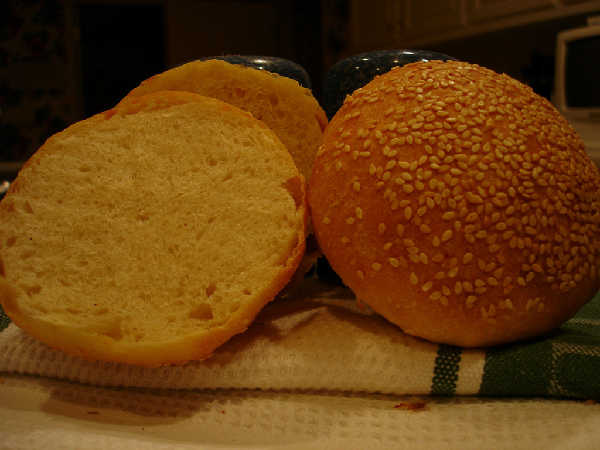 A Hamburger Bun
A Hamburger Bun
I just got a new barbecue grill, so hamburgers were in order. As a home bread baker, I've occasionally made homemade hamburger buns, and there is no question that a hamburger is just better with freshly baked buns.
 A Hamburger Bun
A Hamburger BunI just got a new barbecue grill, so hamburgers were in order. As a home bread baker, I've occasionally made homemade hamburger buns, and there is no question that a hamburger is just better with freshly baked buns.
Tuesday, April 10, 2007
Thursday, March 29, 2007
Wednesday, February 28, 2007
Subscribe to:
Comments (Atom)
